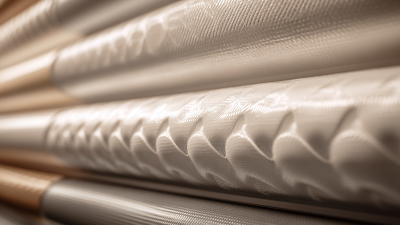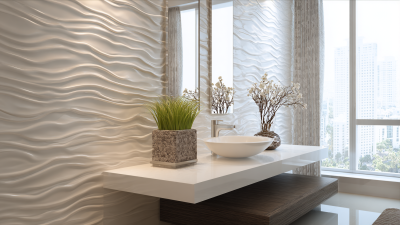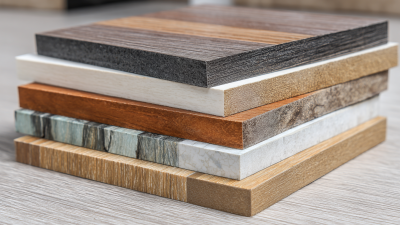Leave Your Message
-
Facebook
-
Whatsapp
-
Whatsapp


In recent years, Plastic Wall Cladding has emerged as a highly sought-after solution for both residential and commercial spaces due to its versatility and durability. According to a report by Market Research Future, the global wall cladding market is projected to reach $303.4 billion by 2024, with plastic materials expected to capture a significant share due to their aesthetic appeal and low maintenance requirements. Moreover, Plastic Wall Cladding offers insulation benefits and moisture resistance, making it an ideal choice for environments prone to humidity.
 As sustainability becomes a focal point in construction, the increasing availability of recyclable options further enhances the appeal of plastic cladding. This guide aims to provide you with all the essential information regarding the benefits and installation of Plastic Wall Cladding, empowering you to transform your space efficiently and effectively.
As sustainability becomes a focal point in construction, the increasing availability of recyclable options further enhances the appeal of plastic cladding. This guide aims to provide you with all the essential information regarding the benefits and installation of Plastic Wall Cladding, empowering you to transform your space efficiently and effectively.
Plastic wall cladding is increasingly recognized for its versatility, making it a favored choice among homeowners and designers alike. This material comes in a variety of styles, colors, and textures, allowing for creative expression and customization in any space. Whether you aim for a sleek, modern look or an industrial vibe, plastic wall cladding can meet diverse aesthetic requirements. Its lightweight nature also simplifies the installation process, making it accessible for DIY enthusiasts and professionals.
In addition to its aesthetic flexibility, plastic wall cladding offers practical benefits such as durability and low maintenance. Resistant to moisture, fading, and wear, it stands up well against the challenges of daily life, particularly in high-traffic areas or rooms exposed to humidity like bathrooms and kitchens. With easy cleaning and maintenance routines, plastic cladding assures a long-lasting and visually appealing finish. Moreover, its insulating properties can contribute to energy efficiency, ensuring a comfortable environment year-round.
Overall, the combination of functionality and artistic potential makes plastic wall cladding a wise investment for transforming any space.
Plastic wall cladding has gained immense popularity in contemporary interior design, offering a myriad of benefits that enhance both aesthetics and functionality. One significant advantage is its durability. Unlike traditional materials, plastic cladding is resistant to moisture, mold, and mildew, making it an ideal choice for areas prone to humidity, such as bathrooms and kitchens. This longevity means that homeowners can enjoy a fresh-looking interior without the frequent need for repairs or replacements.
In addition to its practical benefits, plastic wall cladding also offers a wide range of design possibilities. Available in various colors, patterns, and textures, it allows homeowners to express their personal style effortlessly. The lightweight nature of plastic makes installation a breeze, often requiring less time and effort than heavier materials. This ease of installation, combined with its cost-effectiveness, makes plastic wall cladding a smart investment for those looking to enhance their living spaces while staying within budget.
When considering home improvements, plastic wall cladding presents an attractive and practical option. Not only does it enhance the aesthetics of a space, but it also offers vital benefits related to moisture management. According to Health Canada, indoor mould growth is a significant health hazard that can lead to respiratory issues. Utilizing plastic wall cladding creates a barrier that resists moisture penetration, thus reducing the likelihood of mould development in your home. In fact, studies indicate that homes with effective moisture control solutions exhibit a 50% lower risk of mould presence.
Installing plastic wall cladding is a straightforward process that can be managed with proper guidance. Begin by selecting high-quality materials that suit the specific environment of your space. Preparation is key; ensure the wall surface is clean and dry before installation. When working with plastic cladding, it’s important to use appropriate adhesives or fasteners to secure the panels. Detailed step-by-step guides, highlighting specific measurements and cutting techniques, can simplify the process and result in a smooth finish. By prioritizing safety during installation, including taking precautions against moisture build-up, homeowners can enjoy both the aesthetic and functional advantages of plastic wall cladding.
When embarking on a wall renovation project, selecting the right type of plastic wall cladding is crucial. The market offers a variety of options, each with unique characteristics suited for different environments. For instance, PVC cladding is known for its water resistance and durability, making it ideal for bathrooms and kitchens. On the other hand, acrylic cladding provides a high-gloss finish and is excellent for modern designs, perfect for living areas where aesthetics play a significant role.
Another factor to consider is the thickness and insulation properties of the cladding. Thicker panels generally offer better insulation and soundproofing, which can be beneficial in commercial settings or multi-family units. Additionally, understanding the installation requirements for each type is vital; some claddings are designed for easy DIY installation, while others may require professional assistance. Assessing your project's specific needs, including budget, style, and functionality, will guide you in choosing the most appropriate plastic wall cladding to transform your space effectively.
| Type of Plastic Wall Cladding | Material | Benefits | Preferred Installation Location | Estimated Cost per Square Foot |
|---|---|---|---|---|
| PVC Wall Panels | Polyvinyl Chloride | Water-resistant, easy to clean, and lightweight | Bathrooms, kitchens, and commercial spaces | $3 - $6 |
| Acrylic Wall Panels | Acrylic | High durability, impact-resistant, and clear finish | Living rooms and exhibition areas | $5 - $10 |
| Polycarbonate Panels | Polycarbonate | Excellent insulation, UV resistant, and durable | Exterior walls and greenhouses | $4 - $8 |
| Vinyl Wall Cladding | Vinyl | Rustproof, low maintenance, and various styles | Outdoor siding and fencing | $2 - $5 |
 To keep your plastic wall cladding looking new, regular maintenance is essential. Start by wiping down the surface with a soft cloth and mild soapy water to remove dust and grime. Avoid harsh chemicals or abrasive cleaners that could scratch or degrade the material. It’s advisable to conduct this cleaning routine at least once a month to prevent buildup and maintain the aesthetic appeal of your cladding.
To keep your plastic wall cladding looking new, regular maintenance is essential. Start by wiping down the surface with a soft cloth and mild soapy water to remove dust and grime. Avoid harsh chemicals or abrasive cleaners that could scratch or degrade the material. It’s advisable to conduct this cleaning routine at least once a month to prevent buildup and maintain the aesthetic appeal of your cladding.
In addition to regular cleaning, inspect your plastic wall cladding for any signs of damage or wear. Look for cracks, discoloration, or loose panels. Promptly addressing these issues can prevent further damage and prolong the lifespan of your cladding. If you notice any significant wear, consider applying a UV protectant to shield the material from sun exposure, which can cause fading. By following these simple maintenance tips, you can ensure your plastic wall cladding remains vibrant and functional for years to come.






